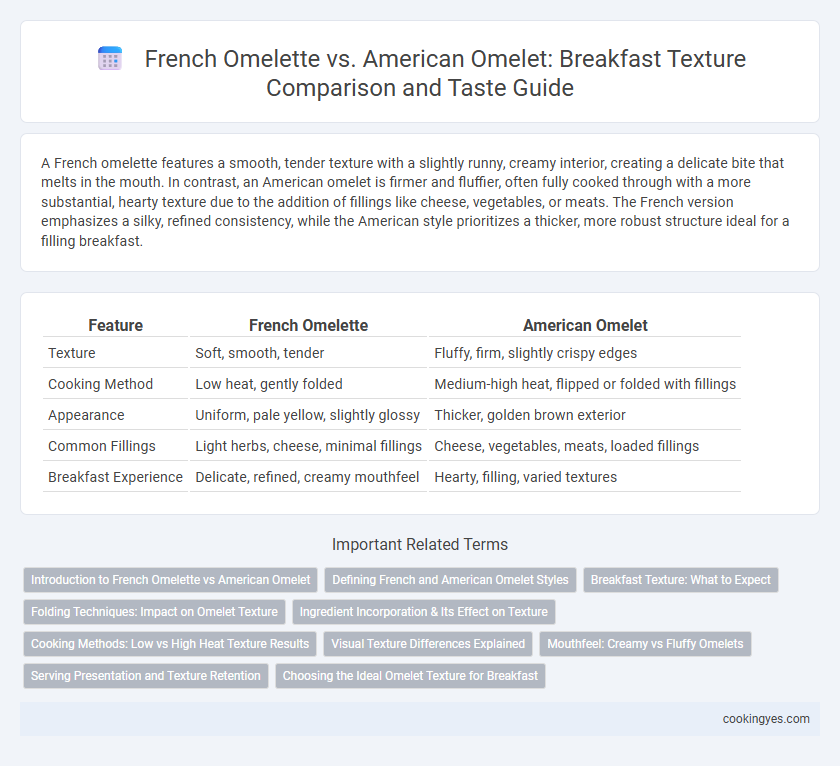A French omelette features a smooth, tender texture with a slightly runny, creamy interior, creating a delicate bite that melts in the mouth. In contrast, an American omelet is firmer and fluffier, often fully cooked through with a more substantial, hearty texture due to the addition of fillings like cheese, vegetables, or meats. The French version emphasizes a silky, refined consistency, while the American style prioritizes a thicker, more robust structure ideal for a filling breakfast.
Table of Comparison
| Feature | French Omelette | American Omelet |
|---|---|---|
| Texture | Soft, smooth, tender | Fluffy, firm, slightly crispy edges |
| Cooking Method | Low heat, gently folded | Medium-high heat, flipped or folded with fillings |
| Appearance | Uniform, pale yellow, slightly glossy | Thicker, golden brown exterior |
| Common Fillings | Light herbs, cheese, minimal fillings | Cheese, vegetables, meats, loaded fillings |
| Breakfast Experience | Delicate, refined, creamy mouthfeel | Hearty, filling, varied textures |
Introduction to French Omelette vs American Omelet
French omelettes feature a smooth, tender texture achieved by gently cooking beaten eggs in butter and folding them softly, resulting in a delicate, slightly moist surface. American omelets typically have a firmer, fluffier texture due to vigorous whisking and cooking over higher heat, often filled with diverse ingredients like cheese, vegetables, and meats. The contrasting techniques create distinct breakfast experiences, with the French style emphasizing refinement and the American style highlighting heartiness.
Defining French and American Omelet Styles
French omelettes feature a smooth, tender texture achieved by gently cooking beaten eggs until just set, often folded into a soft, slightly runny center. American omelets are typically thicker and fluffier, cooked more thoroughly, and filled with ingredients like cheese, vegetables, and meats, creating a heartier breakfast option. The key distinction lies in the French omelette's delicate, silky consistency versus the American omelet's robust, fully cooked texture with integrated fillings.
Breakfast Texture: What to Expect
French omelettes feature a delicate, silky texture with soft, slightly runny interiors that melt in the mouth, ideal for a light breakfast experience. American omelets offer a thicker, fluffier texture with fully cooked interiors, providing a hearty and filling start to the day. The contrast in texture mainly arises from different cooking techniques and ingredient combinations used in each style.
Folding Techniques: Impact on Omelet Texture
French omelettes employ a gentle folding technique creating a smooth, creamy interior with a tender, slightly custardy texture that contrasts with the more structured and fluffy American omelet. The American omelet's multiple folds or roll techniques result in a thicker, airier texture due to extensive egg coagulation and incorporation of fillings. Mastery of these folding methods directly influences the omelet's final mouthfeel and texture profile, defining the classic breakfast experience.
Ingredient Incorporation & Its Effect on Texture
The French omelette features a smooth, creamy texture achieved by gently folding beaten eggs with minimal additional ingredients, preserving the delicate curd structure. In contrast, the American omelet incorporates various fillings like cheese, vegetables, and meats directly into the egg mixture, resulting in a denser, heartier texture with distinct layers. This ingredient incorporation in American omelets creates a more robust mouthfeel, while the French version emphasizes lightness and subtlety.
Cooking Methods: Low vs High Heat Texture Results
French omelettes are cooked over low heat, producing a tender, smooth, and slightly creamy texture with a delicate fold, while American omelets utilize higher heat, resulting in a firmer, fluffier interior with a golden-brown exterior. The low heat cooking method of the French omelette prevents browning and overcooking, preserving moisture and a silky consistency. In contrast, the American omelet's high heat technique accelerates protein coagulation, creating a more robust structure suitable for stuffing with fillings.
Visual Texture Differences Explained
A French omelette features a smooth, silky exterior with a tender, uniform interior, achieved by gentle folding and minimal browning, creating a delicate, custard-like texture. In contrast, the American omelet presents a firmer, slightly browned surface with a fluffier, airier interior due to vigorous whisking and higher heat cooking. These visual texture differences highlight the French style's emphasis on elegance and creaminess, while the American style prioritizes volume and a heartier bite.
Mouthfeel: Creamy vs Fluffy Omelets
French omelettes feature a creamy mouthfeel due to gentle folding and minimal browning, resulting in a smooth, tender texture. American omelets are fluffy with a light, airy interior achieved by vigorous beating and cooking at higher heat. These distinct cooking techniques define the unique mouthfeel differences between French and American omelets during breakfast.
Serving Presentation and Texture Retention
French omelettes feature a smooth, tender texture with a slightly runny interior, served gently folded or rolled for an elegant presentation that retains moisture. American omelets are thicker and fluffier, filled with various ingredients, and typically served open-faced or folded with a sturdier texture designed to hold fillings without breaking. The French style emphasizes delicate mouthfeel and sleek appearance, while the American style focuses on hearty texture and visual abundance in breakfast settings.
Choosing the Ideal Omelet Texture for Breakfast
French omelettes offer a delicate, smooth texture with a slightly creamy interior achieved through gentle folding and minimal browning, ideal for a light breakfast. American omelets typically have a firmer, more cooked texture with a fluffy interior and a golden-brown exterior, often loaded with fillings that add a hearty bite. Choosing the ideal omelet texture depends on personal preference for softness or heartiness and the desired complement to other breakfast components.
French omelette vs American omelet for breakfast texture Infographic

 cookingyes.com
cookingyes.com